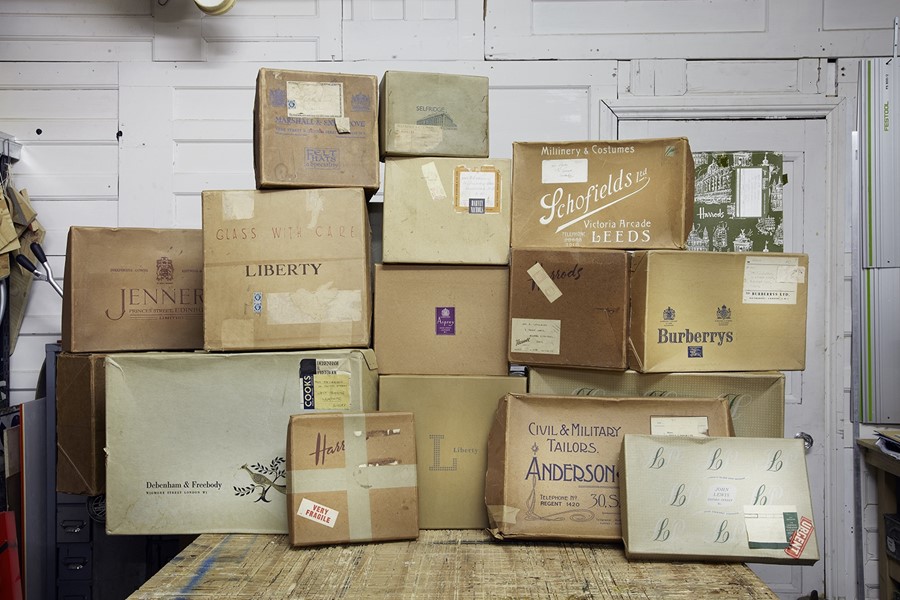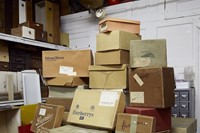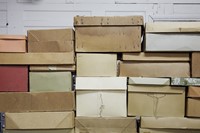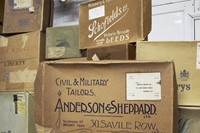Rupert Blanchard discusses his strangely beautiful collection of cardboard boxes
Furniture designer Rupert Blanchard collects vintage cardboard boxes, owning a collection totalling hundreds. He bought his first box at a car-boot sale in Swindon, and now stores the majority at his workshop (the Momosan shop) on Kingsland Road, east London. They act as milestones in the timeline of consumerism in Britain, or a hallmark for the items that they carry. “They normally serve as a date stamp for the contents. No two finds are the same, from tiny dusty loft spaces to the back of a van in the dark at 4am in the winter.”
AnOther touched on Blanchard’s work last year when featuring Ally Capellino’s Bums on Seats project, in collaboration with the London Design Festival. The pair have been working together since meeting when Blanchard was trading at Spitalfields Market while studying Graphic Design at Central Saint Martins.
Since graduating, Blanchard has worked as a furniture designer, maker and collector primarily working with discarded, found and fragmented objects: salvaged billboards, wayward drawers, disregarded packaging and a collection of tubular steel metal chairs. He published the Incomplete Book of Forty Tubular Steel Stacking Chairs in 2011, with his collection having grown considerably since then. “I just seem to enjoy collecting items that are normally overlooked, when their importance is often unrecognised,” Blanchard explains. “I like to think I've helped to raise the profile of these items.” Here he outlines the joys of box collecting and the oddities he has found along the way.
When did you start collecting cardboard boxes?
My first and favourite box was found at the age of about 10 when I discovered some plastic toy soldiers in an old worn cardboard box. It wasn't until a few years later when I had stopped playing with the contents that I started to notice the box that they came in as it sat on a shelf. It was an early 1950s American tomato ketchup box that had been turned into a toy 'fort' by the previous owner to use with the toy figures. Like all kids, I made forts and dens by joining together supermarket boxes, but I guess that I've never grown out of playing with them.
"Like all kids, I made forts and dens by joining together supermarket boxes, but I guess that I've never grown out of playing with them"
Is there any one that is particularly unusual?
I deem every one to be unusual or of importance, I guess that this is the criteria for a place in the collection, however I do really like a box that I have that has been remade and adapted into the form of a brief-case with added leather strap and metal carry handle.
Before cardboard boxes were commonplace, everything came in wooden crates. I find 'cross-over' boxes interesting, these are boxes made with cardboard but reinforced with timber or metal banding/edging before the full strength of engineered cardboard was acknowledged. Early non-corrugated cardboard boxes are normally rather unusual as they were designed to be reused many times over, especially during the war years when materials were in short supply so deposits were often charged for the safe return of a box in good condition. These boxes were often carefully designed and engineered to fold flat for easy return and storage before reuse.
You collect chairs and cardboard boxes: do you find there is any relation between the two?
In a direct connection, I do try to collect boxes for chair manufacturers where possible, but I only have a few for 1930-50s British office chairs. I love the packaging and printed boxes for original Herman Miller Eames chairs and British Hille chairs, they carry a high value due to the connection and rarity. I've never found one by chance, I could go out tomorrow and source one from a mid-century design classic dealer but I'm not a completest hoarder/collector, my life will not be more complete by owning one. That is not the point of my collection. I enjoy celebrating and promoting the importance of the unimportant and overlooked.
Text by Mhairi Graham



